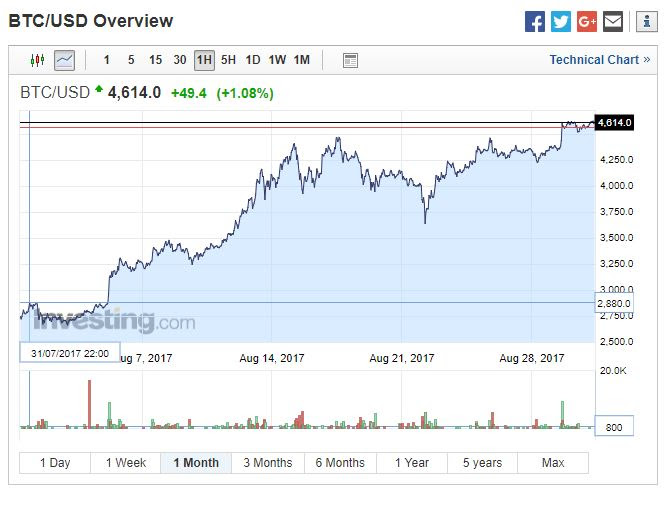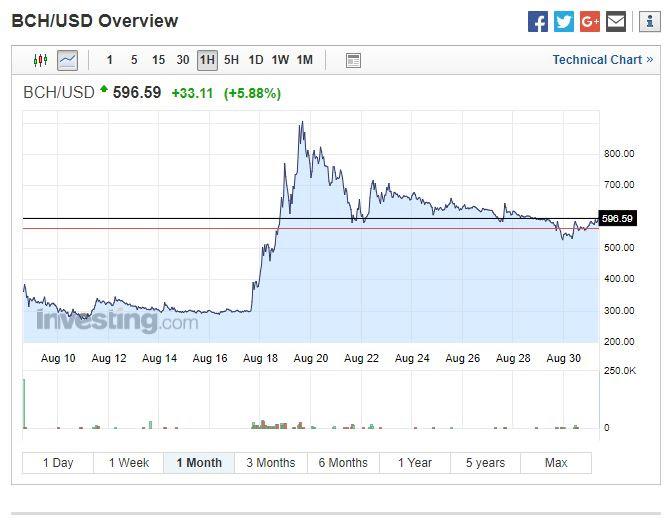Bitcoin nieuws! De Splitsing!
| 4-9-2017 | Erna Erkens |
 Wat is er gebeurd met de Bitcoin per 1 augustus? De Bitcoin is gesplitst! Ik zal het hieronder proberen uit te leggen. Ik voorspel u vast, het is niet eenvoudig. Na de vele discussies over de schaal van de digitale valuta Bitcoin, is er besloten om een geheel nieuwe valuta te maken, de Bitcoin Cash. Het is wel een beetje ingewikkeld allemaal. Het is een resultaat van politieke, technologische en ideologische discussies over het laten groeien van de Bitcoin. Sommige deskundigen zeggen dat een hele nieuwe valuta, genaamd Bitcoin Cash, kan helpen om Bitcoin op grotere schaal toegankelijk te maken voor een grotere groep mensen.
Wat is er gebeurd met de Bitcoin per 1 augustus? De Bitcoin is gesplitst! Ik zal het hieronder proberen uit te leggen. Ik voorspel u vast, het is niet eenvoudig. Na de vele discussies over de schaal van de digitale valuta Bitcoin, is er besloten om een geheel nieuwe valuta te maken, de Bitcoin Cash. Het is wel een beetje ingewikkeld allemaal. Het is een resultaat van politieke, technologische en ideologische discussies over het laten groeien van de Bitcoin. Sommige deskundigen zeggen dat een hele nieuwe valuta, genaamd Bitcoin Cash, kan helpen om Bitcoin op grotere schaal toegankelijk te maken voor een grotere groep mensen.
De afgelopen tijd was er een strijd tussen concurrerende visies,” zegt Zaki Manain, een onafhankelijke cryptocurrency expert. Deze strijd is per 1 augustus voorlopig even gestreden. Om ervoor te zorgen dat de Bitcoin een eenvoudiger wereldwijd betalingssysteem wordt dat iedereen kan gebruiken, moet de Bitcoin over de groeipijn heen geholpen worden. Er is nu voor de oplossing gekozen om een hele nieuwe valuta te maken met soortgelijke blockchain software.
Wat betekent dit nu?
Laat ik beginnen met te zeggen dat uitgeven van de Bitcoin moeilijk en ingewikkeld is.
Bitcoins zijn gebouwd op iets dat blockchain heet. De Bitcoin blockchain is een openbaar grootboek dat alle transactiegegevens bevat van iedereen die Bitcoins gebruikt. Transacties worden toegevoegd aan “blokken” ofwel de koppelingen van codes die een keten (blockchain) vormen. Elke transactie moet in een blok worden opgenomen. Maar deze blokken zijn vol en dit levert een grote vertraging op in de betalingen. Momenteel zijn er gemiddeld ongeveer 1.700 transacties die per Bitcoin block kunnen worden opgeslagen, bij ongeveer drie transacties per seconde, zegt specialist Manain. Dat is niet heel veel. (Visa, bijvoorbeeld, handelt duizenden transacties per seconde).
Omdat de Bitcoin blockchain te druk wordt, kan het gebeuren dat iemand iets betaalt met een Bitcoin, maar dat het heel lang duurt voordat de betaling goedgekeurd wordt. Het verschil is de grootte van de betalingsblokken. De originele Bitcoin heeft blokken van 1 MB die snel vollopen met opdrachten, waardoor het verwerken van betalingen veel tijd kost. En dus duurt het lang voordat de partij waar de betaling aan verricht wordt kan zien dat hij/zij het geld ontvangen heeft. Dat is niet goed voor het vertrouwen. Bij Bitcoin Cash zijn de blokken 8 x zo groot, waarmee de betalingen veel sneller kunnen worden uitgevoerd. Er is ook een poging gedaan om dit probleem op te lossen door een regelwijziging toe te passen op de software. Deze werd genoemd: “Segregated Witness” (gescheiden getuigen. SegWit2X). De regelwijziging zou mensen in staat stellen om meer transacties op elk blok te zetten. Dit wordt in technische termen een “soft fork” genoemd. Sorry, ik kan er ook niks aan doen. Dit zou niet hoeven leiden tot een hele nieuwe cryptocurrency. Deze nieuwe regel zou moeten worden ingevoerd in november. Dit vergroot de grootte van de software van 1 MB naar 2MB. Voor sommigen was dit niet genoeg. Daarom een tweede Bitcoin: De Bitcoin Cash.
Wat is de Bitcoin Cash?
De Bitcoin Cash is een zogenaamde “hard fork” (sorry, ik heb het niet bedacht). De makers zorgen voor een volledig nieuwe software, die het aantal transacties per blok acht keer groter maakt ( 4 x na SegWit2x). Geen idee hoe dit precies werkt. Dit betekent dat Bitcoin Cash transacties veel sneller kunnen worden verwerkt. Bitcoin Cash is niet hetzelfde als de “normale” Bitcoin. Op 1 augustus was een eenheid van Bitcoin Cash USD 240 waard. De echte Bitcoin was toen meer dan USD 2.700 waard.
Bitcoin Cash valt of staat met het vertrouwen van de markt, net als de gewone Bitcoin. Het zal alleen succesvol worden als mensen vaak beslissen om de blokken voor de Bitcoin Cash blockchain te creëren (minen of vinden, zoals u wilt). Het eerste blok is aangemaakt dinsdag 1 augustus.
Hieronder het koersverloop van de Bitcoin Cash tegen de USD van de eerste week:
Wat het betekent voor consumenten en bedrijven?
Voor iedere “oude” Bitcoin die u bezit, bezit u ook een Bitcoin Cash. Echter, niet alle Bitcoin-uitwisselingsplaatsen (de plek waar mensen hun bitcoin opslaan, waar je je Bitcoin wallet hebt een soort van Bitcoin portemonnaie) zullen Bitcoin Cash accepteren. U krijgt alleen Bitcoin Cash erbij als u zelf uw Bitcoins beheert of als u bij een Bitcoin Cash-vriendelijke Bitcoinbeurs zit.
Dit kan een belemmering zijn voor de wereldwijde acceptatie van de Bitcoin Cash. En om Bitcoin Cash te gebruiken voor gewone transacties zoals koffie kopen, zullen bedrijven het moeten accepteren, ongeacht of ze de gewone Bitcoin al accepteren of niet. De toekomst zal uitwijzen of dit gebeurd of niet. “Dit hele proces zal ons veel informatie geven over hoe we in deze toekomst met deze systemen omgaan,” zegt Manain. “Het zal een blauwdruk zijn voor toekomstige ontwikkelingen in de wereld van cryptocurrencies op basis van blockchain. We gaan hier heel veel van leren.
De vraag blijft: welke versie gaan de miners ondersteunen? Bitcoin-miners zetten de enorme rekenkracht van hun computers in voor het ‘ontdekken’ van nieuwe bitcoins. Om dat te kunnen doen zijn ze verplicht om betalingsopdrachten te verifiëren. Zo fungeren ze als verwerkers van de Bitcoin betalingen en zijn dus essentieel voor een betrouwbaar systeem.
Het is mogelijk dat alle Bitcoin-miners overstappen naar de nieuwe versie, waardoor de oude variant niet meer functioneel is omdat er dan niemand meer is om de opdrachten te controleren. Maar de kans bestaat ook dat alleen maar een deel van de miners overstapt. Dan ontstaan er dus zelfs drie versies van de Bitcoin. Het is nog niet klaar met de Bitcoin ontwkkeling.
Hieronder nog het koersverloop van de “gewone” Bitcoin tegen de USD van de afgelopen maand:

Als u vragen heeft hoor ik het graag. Alles rond Bitcoins is flink ingewikkeld. Ik weet niet of ik meteen de antwoorden weet, maar ik ga er in ieder geval naar op zoek.

Owner at Erna Erkens Valuta Advies (EEVA)


 Already over a year treasuryXL facilitates information exchange about corporate treasury. Contributions are, amongst others, about the development of the treasurer as a person. Due to the improved economy we notice a rising interest in this topic. Education, competence development and labour market are the most obvious examples. This is why we start the Treasurer Development initiative.
Already over a year treasuryXL facilitates information exchange about corporate treasury. Contributions are, amongst others, about the development of the treasurer as a person. Due to the improved economy we notice a rising interest in this topic. Education, competence development and labour market are the most obvious examples. This is why we start the Treasurer Development initiative. treasuryXL
treasuryXL

 The treasury community knows us from ‘fresh’ content on a daily basis. A growing number of treasury professionals, our experts, send in articles and blogs and it is our goal to present interesting content that matters to our readers.
The treasury community knows us from ‘fresh’ content on a daily basis. A growing number of treasury professionals, our experts, send in articles and blogs and it is our goal to present interesting content that matters to our readers. Annette Gillhart – Community Manager treasuryXL
Annette Gillhart – Community Manager treasuryXL Facturis
Facturis


 Early 2017, I published a post about PSD2, a lot of opportunities, but also big challenges. Now half a year later, I would like to update you on some developments in this area. PSD2 still needs to be transposed in the national legal system of all the member countries, and according to my knowledge several countries, including Belgium, have not yet released the draft laws. This creates quite some uncertainty in the market, as there will be several country-specific specifications. Hence one can expect that Fintech’s and other TPPs might already have started their certification application in countries that already enacted PSD2 in their local legislation.
Early 2017, I published a post about PSD2, a lot of opportunities, but also big challenges. Now half a year later, I would like to update you on some developments in this area. PSD2 still needs to be transposed in the national legal system of all the member countries, and according to my knowledge several countries, including Belgium, have not yet released the draft laws. This creates quite some uncertainty in the market, as there will be several country-specific specifications. Hence one can expect that Fintech’s and other TPPs might already have started their certification application in countries that already enacted PSD2 in their local legislation. François de Witte – Founder & Senior Consultant at
François de Witte – Founder & Senior Consultant at  An interesting
An interesting 
 In July 2017 our expert Pieter de Kiewit wrote an interesting article about the minor treasury managment of
In July 2017 our expert Pieter de Kiewit wrote an interesting article about the minor treasury managment of 

